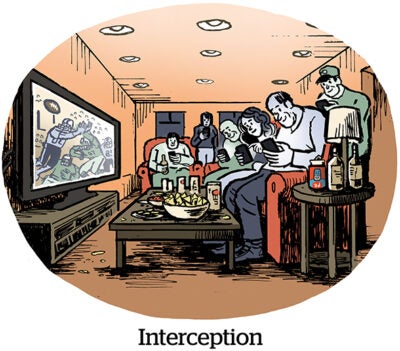We’re halfway through the football season, but streaming sports is just kicking off.
The Amazon Prime “Thursday Night Football” show began in September and it represents the first time that the NFL is streaming games without a linear broadcaster alongside.
This milestone hasn’t been without its challenges.
For example, Amazon’s own self-determined and deterministic audience numbers are markedly higher than its Nielsen ratings.
But Thursday Night Football on Prime is also the start of a new experimental phase as streaming platforms endeavor to prove they can outshine linear in terms of the quality of the broadcast and how the media works for advertisers.
In the past, one of the main barriers for streaming was the quality of the stream itself, which was often beset by issues such as buffering, reloading and ads not serving in time. Every home router was a potential pinch point.
But with broadly distributed internet that can handle the stream, streaming media can begin to flex its muscles.
Take a bet
DraftKings, one of Amazon Prime’s Thursday Night Football sponsors, runs TV-style commercials throughout the game and is the title sponsor of the pre-game show.
These are fairly standard traditional TV sports broadcast sponsor placements, DraftKings CMO Stephanie Sherman told AdExchanger. But streaming-first broadcasters bring a different mentality.
“We are extremely excited to have been selected by Amazon for the partnership for Thursday Night Football,” she said.
Wait … selected? That’s not the language you’d typically hear from a sponsor.
“I know,” Sherman said, “but it was quite a competitive process.”
Worth it, though, she said.
Although it’s possible that other sports betting apps might advertise during commercial breaks in the game, there is an exclusive element to the partnership DraftKings has with Amazon.
“The on-air talent can talk about DraftKings previews that can be parlayed in the upcoming game,” Sherman said.
Second screen opportunity
But where Amazon Prime really differentiates, according to Sherman, is in its ability to guide consumers through a second-screen viewing experience in real time.
The on-air talent could take out their phones and direct viewers to specific bets or combinations of bets in the DraftKings app (bedecked with NFL promos, no doubt). During breaks in the game, there is an understanding, too, that people may be pulling out their phones or pulling up a search engine – and that’s seen as an opportunity.
The goal of a linear broadcast is to maintain viewers on the television screen. Advertisers might attribute search traffic to a commercial during a game if they see a jump after it airs, but TV broadcasters are not looking to push audiences to their second screens during breaks.
But Amazon understands full-funnel marketing, Sherman said.
People don’t download DraftKings on Amazon, and you can buy cruise tickets or cars on Amazon either. (Carnival Cruise Line and Mercedes-Benz are two other title sponsors of Thursday Night Football.)
But working with Amazon is an opportunity to understand, in conjunction with a media company’s first-party data signal, how upper-funnel branding partnerships such as with the NFL can translate into downloads, in-app revenue and engagement.
“We’re really excited about all the different ways in which activating this partnership provides ample opportunity for us to leverage different metrics and methodologies,” Sherman said.
The Amazon angle
The fact that Amazon is streaming-first is appealing to the NFL, said Danielle Carney, Amazon’s head of NFL ad sales.
One benefit is the age of Amazon’s audience. While linear TV’s footprint hasn’t diminished so much among people 60 years and older, linear broadcasts are largely missing younger audiences.
Amazon’s viewers are eight years younger, on average, Carney said, and Thursday Night Football is the number one program among 18 to 34-year-olds across broadcast and cable. This combo sets the NFL’s lone streaming broadcast apart from the rest of its TV portfolio, she said.
Obviously, Amazon also has a big opportunity of its own.
Audible, the Amazon audiobook service, is another title sponsor, and Amazon also runs house ads for Prime to promote “Lord of the Rings” and other Amazon shows. Plus, as a streaming-only broadcast, Thursday Night Football is now also a chance to force linear customers who don’t have Prime subscriptions to download the service.
But as a streamer Amazon can create other unique opportunities for itself, Carney said.
Typically, an NFL game that’s been shown on TV will segue into a buffer zone of local or general news as broadcasters like Fox, NBC or ESPN return to their regularly scheduled programming.
Amazon, however, has a post-game show called NightCap where quarterbacks are brought back out onto a small set assembled on the field to discuss the game. This creates an entirely new sponsorship booking.
“Because we’re in a streaming environment,” Carney said, “we [can] continue the conversation and lean into the NFL programming.”
Since the NightCap show is set in the stadium itself, the players are also surrounded by fans. Primarily drunk fans. This gives the segment a different vibe, to say the least, and is full of social media videos and shout-outs that also aim to attract a younger crowd.
According to Amazon, the audience for NightCap is, on average, 20 years younger than the audience for late-night TV.
And “it’s delivering huge audiences – more than the late-night talk shows are delivering at the moment,” Carney said, “which is extremely interesting to us.”















